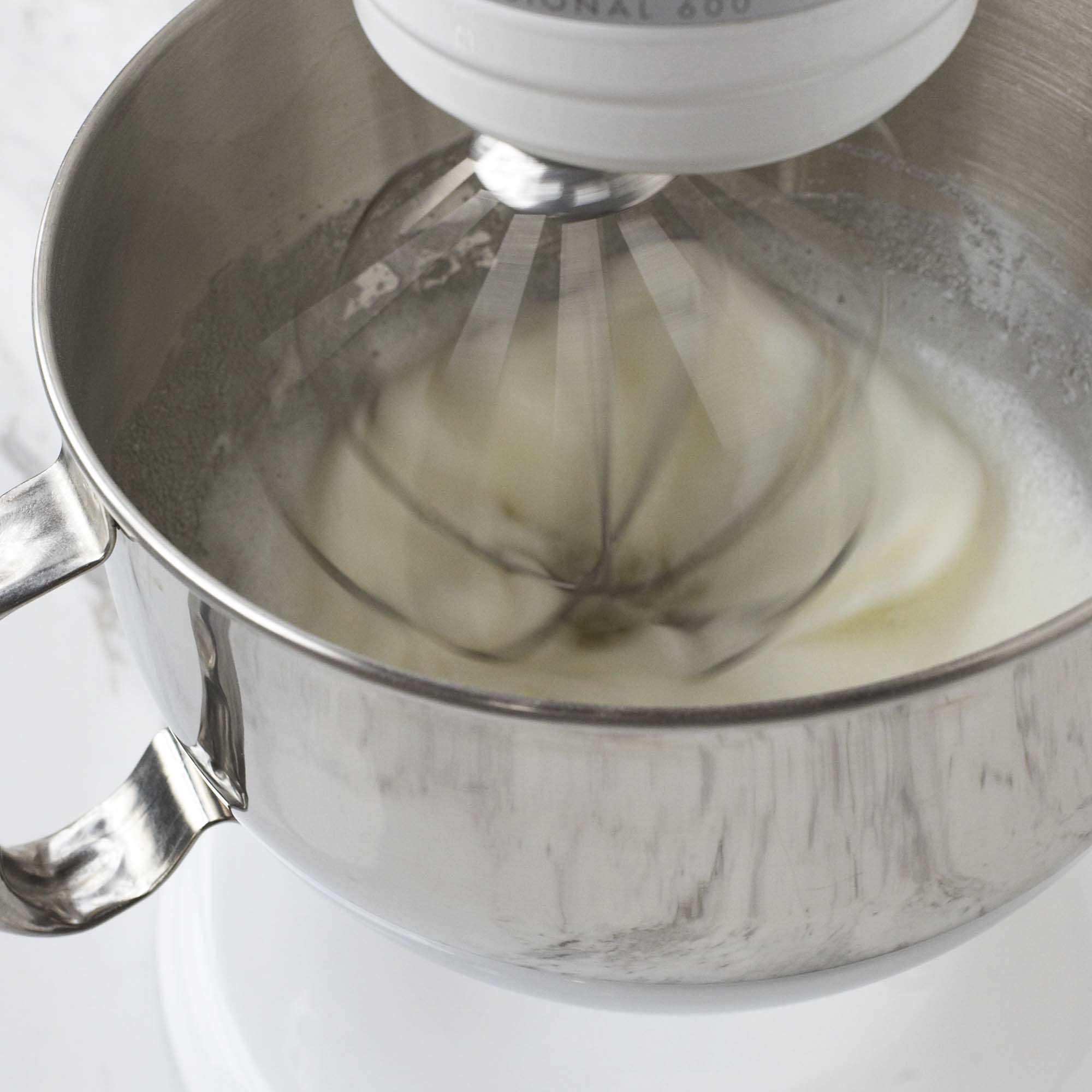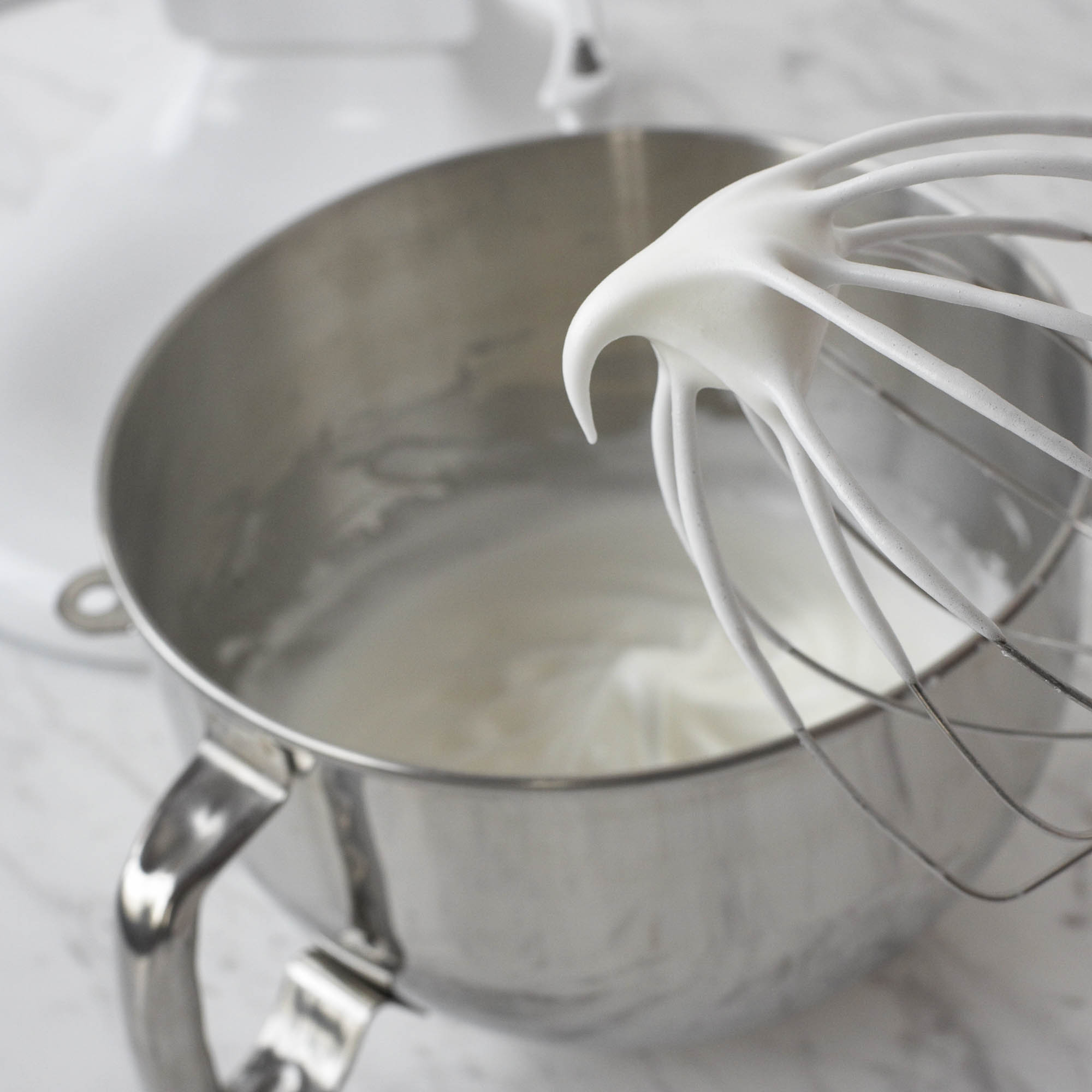If you like soft meringue, these tips and tricks will teach you how to make soft meringue like a master.
Ingredients and Directions
Directions

BEAT egg whites and cream of tartar in mixer bowl with whisk attachment on high speed until foamy.

Beating constantly, ADD sugar, 1 Tbsp. at a time, beating after each addition until sugar is dissolved before adding the next. (Rub a bit of meringue between thumb and forefinger; it should feel completely smooth.) Continue beating until whites are glossy and stand in soft peaks. BEAT IN vanilla.
Ingredients
- EGG WHITES, room temperature 3
- tsp. cream of tartar 1/4
- Tbsp. sugar 6
- tsp. vanilla 1/2
Enjoy
This soft meringue recipe demonstrates the ingredients, proportions and techniques you’ll need to make basic soft meringue.
Soft meringue is used to top pies (Lemon Meringue Pie) and other desserts, such as rice and bread puddings and Baked Alaska. It’s a component of many dessert soufflés (Hot Chocolate Soufflé; Pumpkin Soufflés), Angel Food Cake and sponge cakes (Basic Sponge Cake Roll; Cannoli Cake Roll; Chocolate Yule Log).
Shaped into ovals and poached, it becomes Oeufs a la Neige (Eggs in Snow or Floating Island). The ovals float in a pool of creamy custard (Vanilla Custard Sauce) and are drizzled with chocolate, strawberry or caramel sauce.
Insider Tips on How to Make a Perfect Soft Meringue
For pies and puddings: QUICKLY spread soft meringue evenly over HOT filling, starting at edge and sealing to crust all around. Swirl into peaks with back of spoon. BAKE in upper third of preheated 350°F oven until meringue is lightly browned, 12 to 15 minutes. Cool on wire rack 30 minutes to 1 hour.
If soft meringue pie topping is made with more than 3 egg whites: Bake at a lower temperature (about 325°F) for a longer time (25 to 30 minutes) so the soft meringue has time to reach 160°F without burning.
Cook to 160°F. Soft meringue should be cooked to an internal temperature of 160°F.
A hot filling is important. The heat of the filling cooks the bottom of the soft meringue and prevents it from weeping and creating a slippery layer between filling and topping. Set up your equipment and measure meringue ingredients before you make the filling and work quickly to make soft meringue before filling cools.
To poach soft meringue: Drop spoonfuls of soft meringue into simmering water in large saucepan or deep skillet. Meringue will expand as it cooks so leave space between spoonfuls and poach in batches, if necessary. Simmer, uncovered, turning once, until firm, about 5 minutes. Remove with slotted spoon. Drain on paper towels. Serve warm or refrigerate.
Choose a dry day. Humidity is a critical factor in making soft meringue. Because sugar is hygroscopic (moisture-absorbing), soft meringue made on a humid day can become limp and sticky.
Bowl size (and shape) matters. For proper aeration, a small mixer bowl is best for up to 3 egg whites; a large mixer bowl for 4 or more egg whites. When beaten, egg whites increase as much as 6 to 8 times in volume. The bowl should be large enough to hold the expanding whites, but not so large that the whites are spread too thin. The bowl should be deep enough for the beaters to make contact with as much of the whites as possible.
Keep the yolks separate from the whites. Fat from egg yolk will prevent egg whites from beating properly. When separating eggs, take care that no yolk gets in the whites. To avoid an accident, separate each egg white into a cup or small bowl before transferring it to the mixer bowl. Discard any white that has even a speck of yolk in it.
Equipment: Beaters and bowl should be spotlessly clean. Any residue of fat will prevent egg whites from beating properly. Use a stainless steel or glass bowl. Plastic bowls can retain a film of grease.
Egg temperature: It’s easiest to separate eggs cleanly when they are refrigerator cold. However egg whites whip to greater volume when they’ve had a chance to warm a bit, 20 to 30 minutes. Always begin by separating the eggs. Let the whites stand at room temperature while you prepare the baking pan, equipment and other ingredients.
Cream of tartar: The air beaten into egg whites can be lost quite easily. A small amount of acidic ingredient, such as cream of tartar, acts as a stabilizing agent. A bit of lemon juice or vinegar will also work.
Salt decreases egg-white foam stability, so it is not used in soft meringues.
Add sugar gradually. For optimum volume and smoothest texture, sugar should be added gradually, beginning only after the whites have been beaten to the foamy stage (about double in volume). Adding some or all of the sugar before beginning to beat will result in less volume.
To check if sugar is dissolved: After each addition, whites should be beaten until sugar has dissolved before adding more. To test, rub a bit of meringue between thumb and forefinger. If sugar is dissolved, it will feel completely smooth. If it feels grainy or sandy, continue beating. Undissolved sugar can cause sugar spots on the soft meringue surface.
What’s a soft peak? Soft meringue should be beaten until it appears glossy and stands in soft peaks that curl at the tips when the beater or whisk is lifted. If the peaks stand straight and tall (stiff peaks), the meringue has been overbeaten.
Sugars: Soft meringue usually has a ratio of 2 Tbsp. sugar per egg white. It can be made with any sugar. One cup of superfine sugar or packed brown sugar is equal to 1 cup of granulated sugar; 1-3/4 cups powdered sugar equals 1 cup granulated. Superfine sugar may dissolve more readily and produce a smoother glossier meringue, but volume will not be as great. Powdered sugar contains cornstarch, which may produce a drier meringue.
Mixers: Using an electric portable or stand mixer on high speed is easiest. Soft meringue can be beaten with rotary beater or balloon whisk, but requires more than average arm strength and endurance.
Shaping: Pipe soft meringue through a pastry bag for fanciful shapes or fluted edges, or simply spread and shape it with the back of a spoon or a spatula.
